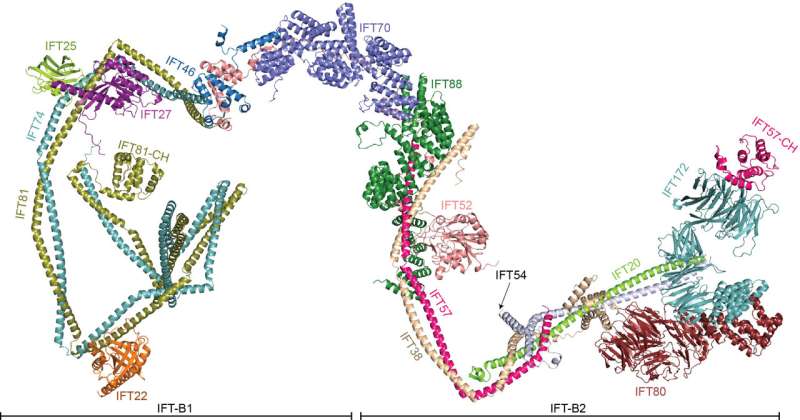Researchers reveal the structure of the IFT-B complex, essential for formation of the cilium organelle

Cilia are organelles that provide eukaryotic cells with motility, sensory reception and intracellular transduction of external stimuli. They are constructed and maintained by the bi-directional movement of 22 different proteins that organizes into IFT-A and IFT-B complexes powered by molecular motors.
Failure to construct cilia in human cells results in syndromic diseases known as ciliopathies that can manifest as deafness, blindness, obesity, inversed positioning of organs, accumulations of liquid in the brain, formation of cysts in the kidney, skeletal abnormalities, polydactyly, infertility and recurrent lung infections.
Although the first structural analysis of IFT proteins were published 11 ago, the complete structural analysis of larger IFT complexes has been hampered by technical difficulties and posed significant challenges. These include the high degree of flexibility and multiple conformations adopted by IFT complexes, which is likely necessary to orchestrate interactions with multiple different cargo proteins.
Now a team of researchers from the Laboratory of Esben Lorentzen at the Department of Molecular Biology and Genetics, Aarhus University, together with research teams from Odense, Germany and Switzerland, used recent advances in structure prediction to reveal the structure of the 15-subunit IFT-B complex. The results are published as a research article in the EMBO Journal.
With the new results, another step has been taken to gain more knowledge about cilia so that in the long term, new drugs can be developed that can fight the diseases associated with the lack of construction of cilia.
From structure prediction towards experimental validation and biological impact
The structural model of the almost complete IFT-B complex represents the culmination of more than a decade of research into the mechanisms of cilium formation.
The IFT-B structure reveals an elongated and highly flexible complex consistent with previous low-resolution in situ cryo-electron tomographic reconstructions of IFT proteins polymerized into trains. Interestingly, the new data reveal two configurations of the IFT-B complex that may reflect the conformational changes necessary to drive the IFT trains bi-directionally.
The research group's data present a structural framework to understand IFT-B complex assembly, function, and ciliopathy variants. IFT is essential for cilium formation and organismic development as highlighted by IFT54 mutant mice that cannot form cilia and thus fail in proper embryonic development. Patients suffering from ciliopathies caused by mutations in IFT-B genes are thus expected to produce viable IFT particles that support at least some degree of cilium formation and function.
The researchers mapped onto IFT-B structure over 15 prominent ciliopathy mutations causing Bardet-Biedl syndrome, short-rib thoracic dysplasia or asphyxiating thoracic dystrophy. These disease variants tend to interfere with IFT-B stability and cargo loading, particularly for the most severe ciliopathies.
More information: Narcis A Petriman et al, Biochemically validated structural model of the 15‐subunit intraflagellar transport complex IFT‐B, The EMBO Journal (2022). DOI: 10.15252/embj.2022112440
Journal information: EMBO Journal
Provided by Aarhus University





















